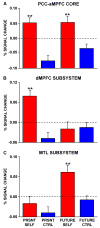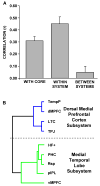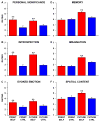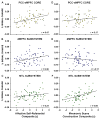Functional-anatomic fractionation of the brain's default network
- PMID: 20188659
- PMCID: PMC2848443
- DOI: 10.1016/j.neuron.2010.02.005
Functional-anatomic fractionation of the brain's default network
Abstract
One of the most consistent observations in human functional imaging is that a network of brain regions referred to as the "default network" increases its activity during passive states. Here we explored the anatomy and function of the default network across three studies to resolve divergent hypotheses about its contributions to spontaneous cognition and active forms of decision making. Analysis of intrinsic activity revealed the network comprises multiple, dissociated components. A midline core (posterior cingulate and anterior medial prefrontal cortex) is active when people make self-relevant, affective decisions. In contrast, a medial temporal lobe subsystem becomes engaged when decisions involve constructing a mental scene based on memory. During certain experimentally directed and spontaneous acts of future-oriented thought, these dissociated components are simultaneously engaged, presumably to facilitate construction of mental models of personally significant events.
Figures







References
-
- Addis DR, Pan L, Vu MA, Maiser N, Schacter DL. Constructive episodic simulation of the future and the past: distinct subsystems of a core brain network mediate imagining and remembering. Neuropsychologia. 2009;47:2222–38. - PubMed
-
- Amodio DM, Frith CD. Meeting of the minds: the medial frontal cortex and social cognition. Nat Rev Neurosci. 2006;7:268–277. - PubMed
-
- Andreasen NC, O'Leary DS, Cizadlo T, Arndt S, Rezai K, Watkins GL, Ponto LL, Hichwa RD. Remembering the past: two facets of episodic memory explored with positron emission tomography. Am J Psychiatry. 1995;152:1576–1585. - PubMed
-
- Andrews-Hanna JR, Huang C, Reidler J, Buckner RL. Functional connectivity within the default network linked to spontaneous internal mentation. Poster presented at the 38th Annual Society for Neuroscience Meeting; Washington, D.C.. 2008.
Publication types
MeSH terms
Grants and funding
LinkOut - more resources
Full Text Sources
Other Literature Sources
Medical

